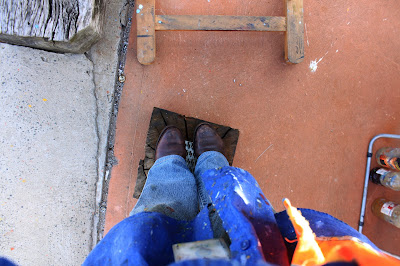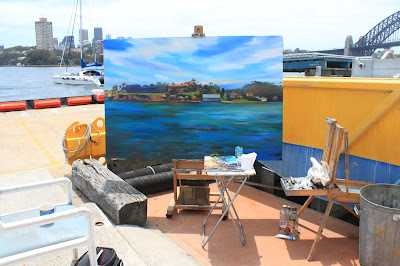 |
MW16 'North Barangaroo Headland Park- The 'Blue Line' from Moore's Wharf ' 2011 oil on canvas 31 x 61cm |
Apart from the recent Open day in June, Barangaroo would still probably be an unfamiliar location to most people, unless they live or work locally.
In the background of these 2 paintings, Balmain is the headland on the left, Goat Island is on the right, and in the centre distance is Ballast Point in Birchgrove. Ballast Point, formerly a derelict refuelling depot, was refashioned into a park in 2008 by the Sydney Harbour Foreshore Authority. I'd been lucky enough to be able to paint a series of paintings at Ballast Point just before its transformation.
Some of the structures which were around the Ballast Point fuel tanks are still in a rusting heap mouldering away behind the White Bay Power Station, and can be seen in a couple of paintings I created on site as Artist in Residence at the White Bay Power Station.
On the concrete of the former wharf, there's a blue line painted in a series of stylized curves and zig-zags , to divide land from sea. A little like the line painted on many Sydney streets for the marathon of the 2000 Sydney Olympic Games, which is still visible in the oddest places.
No Olympic athletes here, just the odd local jogger or dog walker.
It's also a weird echo of the seemingly abstract lines of different colours used in its previous incarnation as a wharf, to distinguish pedestrian walkways from truck parking zones.
On the southern side of the line the sign "Headland Park" has been painted on a green background. On the other side of the line "Sydney Harbour" has been painted in the now ubiquitous Barangaroo blue.
Soon after this was painted, excavation began.
According to the Barangaroo Delivery Authority, the coastline is intended to follow the contours of the shore as it was before European settlement.
Liiterally, "cut along the dotted line".
 |
| MW28 'North Barangaroo Headland Park - The caissons from Moore's Wharf ' 2013 oil on canvas 36 x 46cm Enquiries about this painting |
And, as you can see, they did.
This was painted in February 2013.
By this stage, the skin of the concrete surface has been pierced.
The caissons of the north end of the wharf are now exposed and full of water like a lot of tiny swimming pools.
The geometric symmetry of the wharf still remains, but mounds of sand and gravel hint at the new shoreline yet to come.
Soon the straight edge of the wharf will be broken, the caissons removed and the yellowblock sandstone will be carefully positioned around the new shoreline.
Lashed to the Mast - Plein Air painting, Moore's Wharf
























.JPG)